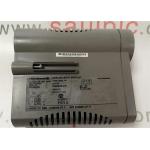GE FANUC IC697ALG440 , Current Expander Module , Series 90-30Product Description
IC697ALG440 is a current expander module, which can be paired with
a GE Series 90-30 base converter module. The completed analog
subsystem includes the base converter and expander modules.
IC697ALG440 has 16 individually configurable differential inputs
for current or voltage. The base converter accepts bipolar or
unipolar analog inputs of up to 10 volts on the full scale. In
addition, the base converter will accept 4 to 20 milliamp current
loop signals. IC697ALG440 offers individual user scaling for each
of the module’s input channels. The complete subsystem accepts a
maximum of 120 inputs. Jumpers and DIP switches are not required,
and a fast update rate is normal for the base converter.
Configuration is compatible with Windows or MS-DOS software
functions.
Inputs are converted to digital form for CPU use or for controllers
accessing analog inputs via the VME backplane. Inputs are protected
against transient and steady state overvoltage conditions. Percent
AI references via the analog inputs are utilized in the
programmable controller; however, a maximum of 8k words of memory
is presently available. Each input channel is set to use one word
of %AI memory at 16 bits. Configuration is executed through the use
of MS-DOS or Windows software. Field wiring is available to make
use of a removable terminal board, and the module is mechanically
keyed to correct replacement. I/O references are configured by the
user, which as previously mentioned, eliminates the need for
jumpers and/or DIP switches. Technical Specifications
| Voltage Input Range: | -10 to +10 volts | | Current Input Range: | 4 to 20 mA | | Calibration: | Factory set at 10 volts +/- 2mV | | No of Inputs: | 16 current inputs | | Module Type: | Analog Input Expander Module | | Power: | + 5 volts |
Technical InformationSpecifications | Input Ranges: | Voltage: –10 volts to +10 volts Current: 4 to 20 milliamps | | Resolution: | Default Scaling (16 bit) 312.5 microvolts per LSB step on voltage
0.5 microamps per LSB step on 4 to 20 mA No missing codes over 16
bits on voltage No missing codes over 14 bits on current NOTE: User
scaling may introduce skipped codes in the lower 2 or 3 bits
depending upon the factors used. | | Accuracy: Calibration | Factory set at full scale = 10 volts ±2 millivolts on Base
Converter module. Maximum errors at 25° C (77°F) are: Base
Converter Voltage, ±.01% of full scale, ±.02% of value Base
Converter Current, ±.05% of full scale, ±.1% of value Expander
Voltage, ±.03% of full value, ±.02% of value Expander Current, ±.07% of full scale, ±.1% of value | | Base Converter | Continually self-calibrates for zero and positive full scale
(before user scaling) values. Field calibration not normally
required; there is no zero adjustment. A trimpot on the Base
Converter adjusts full scale value at 10V input. For critical applications this can be reset to compensate for ageing of
the reference. | | Accuracy: Linearity | ±.02% of full scale over entire negative to positive range. | | Temperature Coefficient | ±5 PPM per °C typical ±15 PPM per °C maximum, voltage ±30 PPM per
°C maximum, current | | Input Impedance: | Voltage Inputs: Greater than 10 megohms at DC AC impedance, 20K
ohms in series with 0.47 mfd capacitor. Current Inputs: 250 ohm,
0.1% precision shunt | | Common Mode Rejection: | Voltage Range - Peak signal input must be between +13 and –13 volts
with respect to the ANLGCOM terminal. | | Sensitivity: | Response to common mode signals within the above limits is
typically 70 dB CMRR, corresponding to a .02% full scale reading
for a 0V input at 10 volts common mode. NOTE: Continuous input
signals beyond the common mode range can result in abnormal
conversions without causing alarms. | | Crosstalk: | High-speed inputs on the Base Converter module may show some
interaction between adjacent channels. This is typically .04% of
the difference between the affected input and the adjacent channel
input levels. The effect can be minimized by arranging inputs with
similar levels on adjacent channels. There is no measurable
interaction between Expander input channels. | | Conversion Rate: | Base Converter inputs updated sequentially about every 2.4 ms to
2.8 ms (maxi- mum) for all 8 channels. One Expander input updated
during each scan of the Base Converter inputs. Time between
Expander updates = 44.8 x N ms (N = number of Expander modules present). |
| Response Time: | Each input has a low pass filter with a 100 radians/second (0.01
second) cutoff. A digital filter on the Base Converter input
channels adds a second pole at 450 radians/second. A sample and
hold maintains full resolution. Settling times, to the specified
accuracies, for a zero to full scale step input are as follows: 5.0% 30 milliseconds 1.0% 42 milliseconds 0.5% 51 milliseconds 0.1% 67 milliseconds | | Input Protection: | Inputs isolated from VME backplane - but not between input
channels. They are, however, protected from overvoltage to the
levels listed below. | | Impulse: | Inputs normally not affected by common mode damped ring wave of up
to 1000 volts peak. Common or transverse mode peaks up to 2500
volts cause no damage, but may cause occasional bad data if they
occur coincidentally with conversion of the affected channel. | | Continuous Overvoltage: | Inputs survive common mode or normal mode 120 VAC or 125 VDC fault
for at least 1 minute. Longer times may damage input current
limiting resistor. Damage limited to only the affected input. | | Power Requirements: | | | Rack Backplane | +5 volts at 0.8A (4 watts) maximum for Base Converter +5 volts at 0.4A (2 watts) for each Expander module | | Field Side | No power required for the module; however, current for 4 to 20 mA
inputs must be user supplied. |
|









